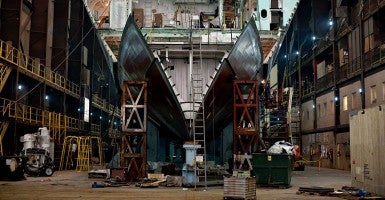When the Ingalls Shipyard closed in Gulfport, Miss., last month, the nation’s shipbuilding capacity reached a critical point.
At Ingalls, the problem was ship design as well as money. First, the Coast Guard passed on composite deckhouses for its new class of fast-response cutters, going to a different design. When the Navy decided to transition from a composite deckhouse like on the first two Zumwalt-class destroyers to a steel one constructed at Bath Iron Works, it proved the knockout blow.
The shipyard announced its decision last year, following through in July, putting 400 shipbuilders out of work, according to local TV station WLOX.
>>> VIDEO: Navy Faces Readiness Crisis as More Ships Unprepared for Combat
The Navy’s 30-year shipbuilding plan is facing a shortfall of funds. Several ship designs, such as the Littoral Combat Ships and Zumwalt-class destroyers, proved to be peppered with cost overruns.
Now, the Navy’s stated goal of a fleet of 306 ships in serious jeopardy.
“If the [Congressional Budget Office] and [Congressional Research Service] are correct, and if Navy’s projected costs prove to be lower in the event, the U.S. fleet will not reach the current goal of 306 ships,” said Seth Cropsey, former deputy undersecretary of the Navy in the Reagan administration and author of “Mayday: The Decline of American Naval Supremacy.”
>>> Defense Cuts Leaving the U.S. Navy Toothless?
With China expanding its fleet and influence, a hollowed-out U.S. Navy will not be able to act as the sharp end of the Obama administration’s “Pacific Pivot,” a shift of forces and emphasis from the Atlantic.
In a time when the world is more dangerous, critics argue the fleet should be growing, not shrinking.
“The world is becoming a more dangerous place, generally, and specifically for untrammeled transit through the sea and air international commons,” Cropsey said.
Piracy breaks out off the Horn of Africa and is controlled only to re-appear off the West Africa coast. China carves out large sections of international waters and claims the area as a critical interest. Russia stations a dozen ships in the Eastern Mediterranean and the U.S. Sixth Fleet is a flickering shadow of its former strength in the region.




























